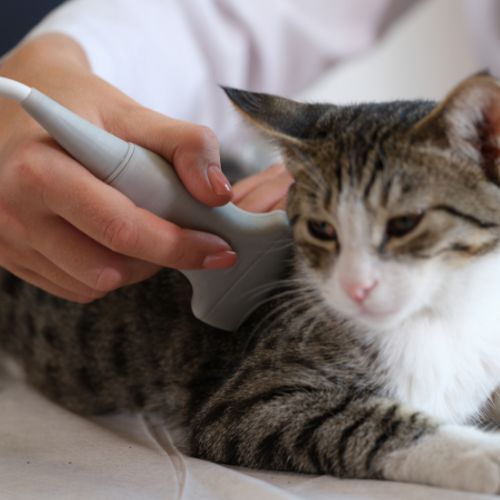Pet Diagnostic Imaging at Evergreen Animal Hospital in Gig Harbor, WA
Digital X-ray technology gives us the ability to manipulate the images that we take so that we are able to diagnose issues that may not be seen on a traditional X-ray.

Pet Ultrasound in Gig Harbor, WA
Ultrasound is an imaging tool that allows us to see the bodies tissues in cross-section. This non-invasive technique often is able to provide a level of detail that can’t be appreciated even with digital X-rays, including movement of your pet’s organs. We are also able to collect needle biopsies into very precise locations, with minimal discomfort for your pet. Currently, we schedule a board-certified radiologist to perform ultrasounds in our hospital. We are typically able to schedule these procedures within 7 days or less.
Using sound waves, pet ultrasound is a diagnostic imaging method that produces live images of your pet’s internal organs. Our veterinarians can see vital organs such as the liver, kidneys, heart, and more with this painless procedure, which gives them important information about the health of the patient.
Pet Radiology
We are able to immediately send a complete copy of the images anywhere in the world, so we can easily consult with a board-certified radiologist. We can also easily send digital copies of the images to your e-mail.
Veterinary diagnostic imaging, another name for pet radiology, is a non-invasive method that lets us look inside your pet’s body to see what’s inside. It involves the detection and diagnosis of a variety of conditions through the use of ultrasounds, X-rays, and other imaging modalities. At Evergreen Animal Hospital, we take great satisfaction in using technology to give your cherished pets accurate and timely results.
When is Pet Diagnostic Imaging Necessary?
When to take your pet for diagnostic imaging depends on a number of factors. Diagnostic imaging can be suggested if your pet is displaying unusual behavior, experiencing pain that doesn’t seem to be related to it, or has mobility problems. Additionally, including imaging in the healthcare plan can help detect age-related conditions early in routine wellness checks, especially for senior pets.
Diagnostic imaging is necessary in trauma cases, such as accidents or falls, to evaluate internal injuries that might not be visible from the outside. Furthermore, routine imaging can be crucial to effectively managing the health of pets with chronic conditions.
